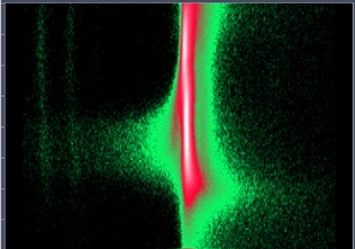
Principles
Investigation of Barrier Discharges by TCSPC
Barrier discharges occur if the electric field between two isolator-coated electrodes exceeds a critical value, see Figure below. The visible discharge phenomenon consists of a large number of micro-discharges with nanosecond duration and kHz frequency.

Barrier discharges are technically highly relevant: They are a degradation mechanism of insulators in electrical systems, and they are used in a wide variety of plasma applications, e.g. for cleanup of exhaust gases. The investigation of the discharges is difficult: They occur at random times, the duration of light pulses is on the order of a few nanoseconds, and the intensity is very low. Ideally, it would be desirable to record the shapes of the optical pulses as a function of the gap voltage and the distance along the gap, for selectable wavelength. Exactly this task can be solved by multi-dimensional TCSPC. The principal setup is shown in the figure below.

The X output of a bh GVD-120 scan controller delivers a sinusoidal output voltage of a frequency of about 10 kHz. The voltage is amplified and drives a high-voltage transformer. The output of the transformer delivers the voltage for the discharge gap. The Y voltage of the scan controller drives a galvanometer mirror. The galvanometer mirror periodically scans the spot from which the light is detected over the discharge gap. The photons are detected by a PMC-150 PMT module via a monochromator.
A second PMT module detects light from the entire discharge gap in a wide spectral range. The light is strong enough to deliver a timing reference for the TCSPC process. The TCSPC module records a photon distribution (or a ‘FLIM’ image) over the phase in the gap voltage (X), the distance along the discharge gap (Y), and the times of the photons in the optical pulses generated by the discharges.
Typical results are shown in the figure below. The images in the upper row show that the pulse shapes are different along the gap. Interestingly, there are weak discharges several 10 ns before the main discharge. These ‘streamers’ occur in mid-air, not in the direct vicinity of the electrodes. The images in the lower row shows that the pulses are also different for different phase in the gap voltage.

For details please see bh TCSPC Handbook, section ‘Barrier Discharges’.
References
References Related to Barrier Discharges
- Becker, Advanced time-correlated single-photon counting techniques. Springer, Berlin, Heidelberg, New York, 2005
- Brandenburg, K.V. Kozlov, P. Michel, H-E. Wagner, Diagnostics of the single filament barrier discharge in air by cross-correlation spectroscopy, 53-rd annual gaseous electronics conference, Houston (Texas) (2000)
- Brandenburg, H.-E. Wagner A. M. Morozov, K. V. Kozlov, Axial and radial development of microdischarges of barrier discharges in N2/O2 mixtures at atmospheric pressure. J. Phys. D: Appl. Phys. 38,1649–1657 (2005)
- Brandenburg, H. Grosch, T. Hoder, K.-D. Weltmann, Phase resolved cross-correlation spectroscopy on surface barrier discharges in air at atmospheric pressure. Eur. Phys. J. Appl. Phys. 55, 13813-p1 to -p6 (2011)
- Hoder, M, Sira, K.V. Kozlov, H.-E. Wagner, Investigation of the coplanar barrier discharge in synthetic air at atmospheric pressure by cross-correlation spectroscopy. J. Phys. D: Appl. Phys. 41 035212-1 to -9 (2008)
- Hoder, R. Brandenburg, R. Basner1, K.-D. Weltmann, K. V. Kozlov,H.-E. Wagner, A comparative study of three different types of barrier discharges in air at atmospheric pressure by cross-correlation spectroscopy. J. Phys. D: Appl. Phys. 43 124009-1 to -8 (2010)
- Hoder, M. Cernak, J. Paillol, D. Loffhagen, R. Brandenburg, High-resolution measurements of the electric field at the streamer arrival to the cathode: A unification of the streamer-initiated gas-breakdown mechanism. Phys. Rev. E 86, 055401-1 to -5 (2012)
- Kloc, H.-E. Wagner, D. Trunec, Z. Navratil, G. Fedosev, An investigation of dieclectric barrier discharge in Ar and Ar/NH3 mixture using cross-correlation spectroscopy. J. Phys. D: Appl. Phys. 43, 345205-34514 (2010)
- V. Kozlov, R. Brandenburg, H-E. Wagner, A.M. Morozov, P. Michel, Investigation of the filamentary and diffuse mode of barrier discharges in N2/O2 mixtrures at atmospheric pressure by cross-correlation spectroscopy, J. Phys. D: Appl. Phys. 38, 518-529 (2005)
- V. Kozlov, V.V. Dobryakov, A.P. Monyakin, VG- Samoilovich, O.S. Shepeliuk, H-E. Wagner, R. Brandenburg, P. Michel, Cross-correlation spectroscopy in investigations of filamentory gas discharges at atmospheric pressure, Proc. SPIE 4460, 165-176 (2002)
- V. Kozlov, H-E. Wagner, R. Brandenburg, P. Michel, Spatio-temporally resolved spectroscopic diagnostics of the barrier discharge in air at atmospheric pressure, J. Phys. D: Appl. Phys. 34, 3164-3176 (2001)
- Navratil., R. Josepson, N. Cvetanovic, B. Obradovic, and Pavel Dvořák, Electric field development in γ-mode radiofrequency atmospheric pressure glow discharge in helium. Plasma Sources Sci. Technol. 25, 03LT01-06 (2016)
- E. Wagner, R. Brandenburg, K.V. Kozlov, Cross correlation emission spectroscopy: application to non-equilibrium plasma diagnostics, Proceedings of Frontiers in Low Temperature Plasma Diagnostics V (2003)
- E. Wagner, R. Brandenburg, K.V. Kozlov, A. Sonnenfeld, P. Michel, J.F. Behnke, The barrier discharge: Basic properties and applications to surface treatment, Vacuum 71, 417-436 (2003)
- E. Wagner, R. Brandenburg, K.V. Kozlov, Progress in the visualisation of filametary gas discharges, part1: Milestones and diagnostics of dielectric-barrier discharges by cross-correlation, Journal of Advanced Oxidation Technologies 7, 11-19 (2004)
